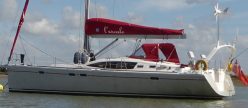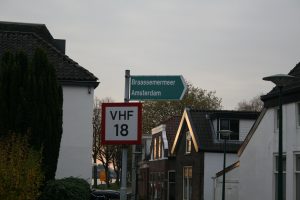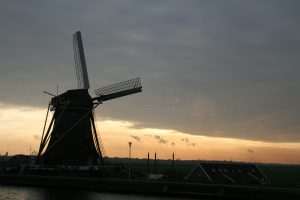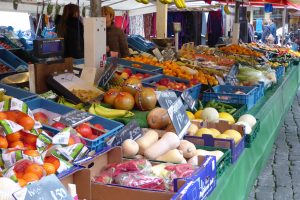Saturday 4 November
The day dawned optimistically, and in spite of feeling below par, Mate decided she’d rather make the most of dry daylight – the weather’s been very calm since we arrived in the Netherlands – to continue to make our way North. We slipped away from the wall, turned neatly in mid-channel, and immediately turned left onto the Oude Wetering for the Ringvaart van de Haarlemmermeerpolder: ooh, how I love trying to get my tongue around these wonderful compound nouns. Ringvaart is a ringway, and polder is a means of draining the land, like a bigger dyke (dijk in Dutch), so we were travelling along the Harlem-lake-ditch-ringway, but it’s so much more colourful in its native language.
Although cold in a fresh Nor’easterly breeze, it was a lovely day for a detour, as per the Pilot’s suggestion, into the Kagerplassen, a lake of many islands and depths varying from shallow to dry. Mate kept a close eye on the chart plotter, but was still able to enjoy the rural idyll of cattle grazing before a backdrop of windmills against a wide, wide sky. Being Saturday, a fleet of traditional gaff-rigged dinghies was out racing with the local Scout troop, and, apart from one German Hanse on transit a couple of days ago, it was the first day we’d seen any other yachts enjoying a late season potter.
We looked at a possible anchorage in the lake, but Mate was keen to keep going, feeling this spot would be rather bleak and exposed if the weather changed. Also, we needed to stop for a couple of nights, as the bridges into Haarlem don’t open on Winter Sundays, and she might want to go ashore…
Back on the Ringvaart, the bridges were coming thick and fast, and we had to weave our way around a number of rowing fours out training. During the afternoon it started to rain and became very unpleasant, and by now we were diligently searching for somewhere to stop, lunch still pending and Mate’s enthusiasm and energy having long since disappeared. Unfortunately, I am much bigger than most of the leisure boats on these waters, and the Dutch system of ‘boxes’ – piles at regular intervals instead of finger pontoons – are generally too narrow for my 4.5 metre beam. I know, I know, I’m a bit hippy and have a wide rear, but I’m very comfortable to live on: what can I say?
Anyway, after the double drawbridge at Cruquiusbrug, we turned left into the Zuider Buiten Spaarne (South Outer…Spaarne? The name of the river, I think) and Skipper spotted a small yacht haven at Spaarneborgh, just up a branch of the canal, nestled amongst a couple of apartment blocks. Mate was able to tuck me into an alongside berth at the entrance, long enough that I wasn’t sticking out into the channel. In the pouring rain, approaching dusk and general misery, happy hour was an extremely brief affair, not that I blamed them, and soon my heads and tech room were a wardrobe of dripping foul weather gear.
Mate managed a small bowl of homemade pumpkin soup and retired to bed, leaving Skipper to make contact with the harbourmaster, plug in the power and later cook himself supper.



